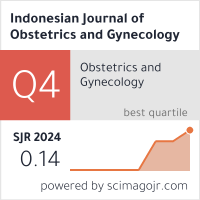The Salivary Estriol Level was Higher in Preterm Delivery Compared to that in Preterm Pregnancy
Abstract
Objective: To know the difference of salivary estriol level between patients with preterm birth and preterm pregnancy of 32-36 weeks and to determine the correlation between the level of estriol in saliva and the incidence of preterm delivery. Methods: This research was a cross-sectional studies of 80 patients in Dr. Hasan Sadikin Hospital and its networks. The subjects are 40 patients in labor and 40 patients in preterm pregnancy, that met the inclusion criterias during the period September 2011 to November 2011. We took the salivary sample and examine the level of estriol. The data were analyzed by Shapiro-Wilk and Mann Whitney test. Result: The study found that the difference of salivary estriol levels in preterm labor and preterm pregnancy groups was statistically significant (p<0.05). The mean salivary estriol levels in preterm labor group was 3438.75 while the mean value of estriol levels in preterm pregnancy group was 686.10 and ranges of each group is 1188-16338 and 88-1180. Conclusion: The value of salivary estriol levels were higher in preterm labor compared to the level in preterm pregnancy. [Indones J Obstet Gynecol 2012; 36-2: 66-70] Keywords: preterm labor, salivary estriol
Downloads
Copyright (c) 2020 Indonesian Journal of Obstetrics and Gynecology

This work is licensed under a Creative Commons Attribution-NonCommercial-ShareAlike 4.0 International License.













